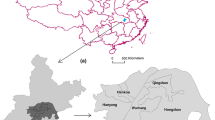Abstract
It is very important to integrate remote sensing with urban geography that the spectral mixture analysis technique is applied to urban land cover evolvement and its eco-environmental effect. Urban land cover is mainly composed of complicated artificial materials, which is the key factor to limit the development of the spectral mixture analysis technique. There are two main aspects in which the technique of spectral mixture analysis is applied to urban geography: one is to calculate vegetation fraction; the other is to build quantitative model of the urban impervious surface obtained from the combination between high albedo fraction and low albedo fraction. The technique of spectral mixture analysis is firstly applied to study urban renewal pattern, scale and mode which happened in Shanghai City from 1997 to 2000.
Similar content being viewed by others
References
Tao Q X, Tao H X, Zhang L P. Study on applying linear mixing spectral model in vegetation classification using hyperspectral remote sensing. Survey Technology (in Chinese), 2004, (1): 21–24
Shimabukuro Y E, Smith J A. Least squares mixing models to generate fraction images derived from remote sensing multispectral data. IEEE Transactions on Geoscience and Remote Sensing, 1991, 29: 16–20
Emma U, Susan U, Deanne D. Mapping nonnative plants using hyperspectral imagery. Remote Sensing of Environment, 2003, 86: 150–161
Small C. Estimation of urban vegetation abundance by spectral mixture analysis. International Journal of Remote Sensing, 2001, 22(7): 1305–1334
Small C. Multitemporal analysis of urban reflectance. Remote Sensing of Environment, 2002, 81: 427–442
Lü C C, Wang Z W, Qian S M. A review of pixel unmixing model, Remote Sensing Information (in Chinese), 2003, 3: 55–60
Small C. The Landsat ETM+ spectral mixing space. Remote Sensing of Environment, 2004, 93: 1–17
Ridd M K. Exploring a V-I-S (vegetation-impervious surface-soil) model for urban ecosystem analysis through remote sensing: comparative anatomy for cities. International Journal of Remote Sensing, 1995, 16: 2165–2185
Wu C S. Estimating impervious surface distribution by spectral mixture analysis. Remote Sensing of Environment, 2003, 84: 493–505
Yao K. The diagnosis for Shanghai urban renewal. Beijing Plan and Construct (in Chinese), 2004, 1: 151–153
Ma J W, Zhao Z M. Buheaosier, Remote Sensing Data Model and Processing Method (in Chinese). Beijing: Chinese Science and Technology Press, 2001, 62–70
Smith M O, Johnson P E, Adams J B. Quantitative determination of mineral types and abundances from reflectance spectra using principal components analysis. Journal of Geophysical Research, 1985, 90: 797–804
Gillespie A R, Smith M O, Adams J B, et al. Interpretation of residual images: spectral mixture analysis of AVIRIS. In: Proceedings of the 2nd AVIRIS workshop, 4–5 June 1990 (Pasadena, CA: JPL): 243–270
Van Der Meer F, De Jong S M. Improving the results of spectral unmixing of Landsat Thematic Mapper imagery by enhancing the orthogonality of end-members. International Journal of Remote Sensing, 2000, 21: 2781–2797
Boardman J W, Kruse F A, Green R O. Mapping target signatures via partial unmixing of AVIRIS data. In: Summaries, Fifth JPL Airborne Earth Science Workshop. JPL Publication 95-1, 1995,1: 23–26
Weng Q, Lu D, Schubring J. Estimation of land surface temperature-vegetation abundance relationship for urban heat island studies. Remote Sensing of Environment, 2004, 89: 467–483
Xu J H, Yue W Z, Tan W Q. Spatial stat. law for the effect of urban sight structure. Acta Geographica Sinica (in Chinese), 2004, 59(6): 1058–1065
Yue W Z, Xu J H, Tan W Q. Spatial scale analysis of the diversities of urban landscape. Acta Ecologica Sinica (in Chinese), 2005, 25(1): 122–128
Author information
Authors and Affiliations
Corresponding author
About this article
Cite this article
Yue, W., Jianhua, X., Wu, J. et al. Remote sensing of spatial patterns of urban renewal using linear spectral mixture analysis: A case of central urban area of Shanghai (1997–2000). CHINESE SCI BULL 51, 977–986 (2006). https://doi.org/10.1007/s11434-006-0977-8
Received:
Accepted:
Issue Date:
DOI: https://doi.org/10.1007/s11434-006-0977-8




